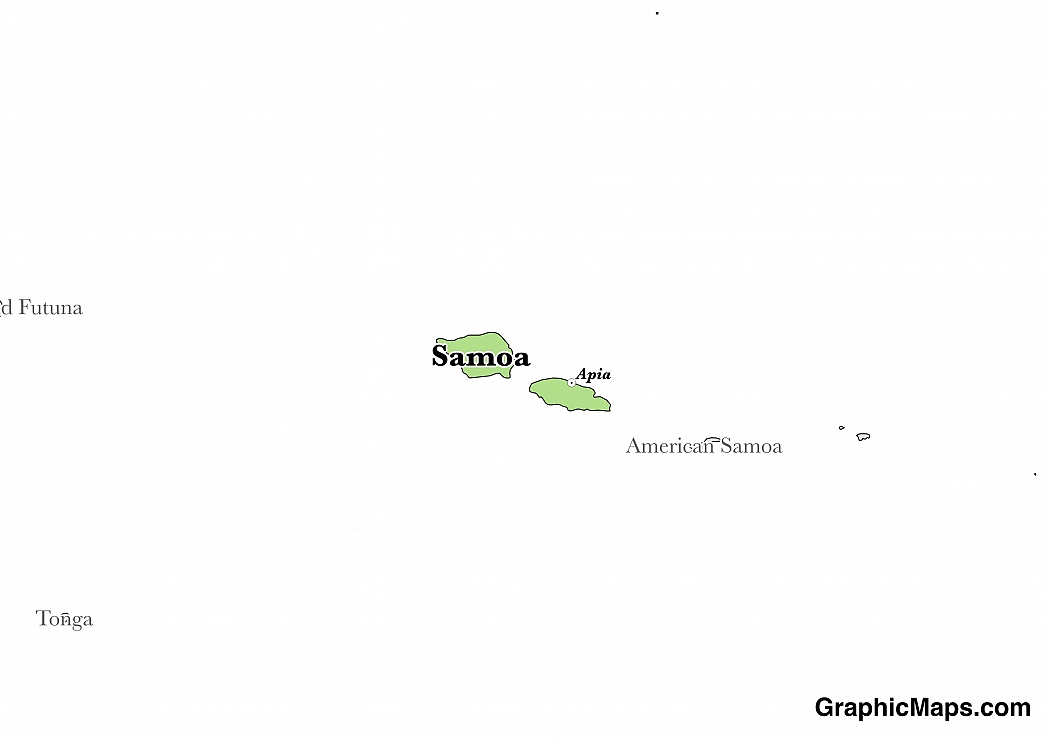Where is Samoa?
Located in Oceania, Samoa is an island nation. It has a 403.00 km coastline.
The capital and most populous city of The Independent State of Samoa is Apia which is located on Samoa’s second largest island, Upolu. The city is situated at the mouth of the Vaisigano River on a natural harbor. Founded in the 1850s Apia served as the capital during the time when Samoa was a German colony. The city became the seat of the government in modern times in 1959. With a geographical area of some twenty square miles Apia is home to an estimated 36,735 residents. One of the area’s most popular tourist attractions is the former home and final resting place of famed Scottish poet, novelist, and travel writer Robert Louis Stevenson. Other noteworthy sites include Apia’s Immaculate Conception of Mary Cathedral as well as the nature park, Palolo Deep Marine Reserve. Apia has a tropical rainforest climate with consistently warm
Read more on Samoa's CapitalSamoa is an Oceanian country covering 2,831.00 km2 of which 0.35% is water and 2,821.00 km2 is land. This makes it the 29th smallest country in the world and slightly smaller than Rhode Island. Its geographic coordinates are 13 35 S, 172 20 W and Apia is the capital city.
The name "Samoa" translates into "Holy Center".
Its ISO code is WS.
Geography
Samoa has a mean elevation of 0 m above sea level.
It has a Mediterranean climate with mild winters and warm summers. Its terrain is mostly volcanic and rugged.
Population
Samoa has a population of 198,926 making it the 183rd largest in the world.
Samoan is the official language spoken. The majority of the popupulation is reported as having Samoan ethnicity. The majority of the population is Roman Catholic.
The Independent State of Samoa has two official languages: Samoan and English. The indigenous language comes from the Austronesian linguistic family of Polynesian languages. The vast majority of Samoans cite Samoan as their mother tongue. Estimated figures from 2005 count the total number of Samoan speakers on the islands to be 246,000 which represents about half of the total of Samoan speakers around the world.
Read more on Samoa's LanguagesThe dialing code for the country is 685.
Government
Samoa is an independent country. It gained independence in 1962, from New Zealand-administered United Nations trusteeship. Its constitution was last ratified in 1960.
The Independent State of Samoa formally gained its independence from New Zealand in 1962. Since then the country has operated as a unitary parliamentary democracy. The Pacific Ocean island’s legislative assembly meets in Samoa’s capital city, Apia in a traditionally styled structure. The Legislative Assembly consists of forty nine members who all serve terms of five years in length. The nation’s two major political parties are the Tautua Samoa Party and the Human Rights Protection Party.
Read more on Samoa's GovernmentEconomy
Factoring in Purchasing Power Parity, Samoa's GDP is $1,046,000,000.00 (USD) with $5,400.00 (USD) per capita. This makes it the 202nd largest economy and its citizens the 160th richest in the world. The currency of Samoa is the Tala (WST).
Its major export partners are American Samoa and Australia. Its main exports are fish, coconut oil and cream, nonu, and copra. Its major import partners are Fiji, New Zealand, and China. Its major imports include machinery and equipment, industrial supplies, and foodstuffs.
Flag
The Independent State of Samoa, which is composed of two main islands and four smaller ones, is located in the South Pacific Ocean. Its flag was initially accepted for U.S. Trusteeships in 1949 and officially became the symbol of Samoa’s political independence on January 1, 1962. The design of the flag features a solid red background with a large blue rectangle positioned in its upper hoist side. Inside this flag is the familiar Southern Cross constellation which features five white stars; four large and one much smaller. Samoa’s official flag symbolizes courage, purity, and the freedom of its people. The use of the Southern Cross constellation also references the important relationship that the island nation enjoys with its larger neighbor, the country of New Zealand. Before adopting its current flag Samoa flew the flag of Germany, who colonized the island until 1914.
Read more on Samoa's FlagThis page was last modified on February 6th, 2018
More on Graphicmaps

Published on 2019-11-06
What is a Trade Embargo?

Published on 2019-11-04
Which Two Countries Used to Have the Same Flag?

Published on 2019-09-16
What Is the Only Two-Sided State Flag?

Published on 2019-09-16
Which Country Flag Looks Like the Texas Flag?

Published on 2019-08-29
Flags That Resemble the US Flag

Published on 2019-08-20
